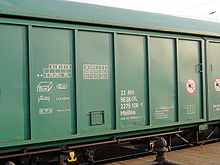- UIC wagon numbers
-
Wagon numbers (or coach numbers) are key data for railway operations. The wagon number enables a railway wagon or coach to be positively identified and forms a common language between railway operators, infrastructure companies and the responsible state authorities. The system of wagon numbering described below has been laid down by the International Union of Railways (Union internationale des chemins de fer or UIC) and is used in a similar way to that used for the locomotives and multiple units.
The complete wagon number comprises 12 digits. The individual digits within the number have the following meaning:
First and second position: Interoperability code (on multiple units Type code) Third and fourth position: Owner's code (since 2006: UIC country code) Fifth to eight position: Type number Ninth to eleventh position: Serial number Twelfth position: Self-check digit Contents
Calculation of the control digit
The digits of the wagon number are multiplied individually from left to right alternately by 2 and 1. Then the sum of the digits is produced. The difference between this sum and the next multiple of ten is the control or check digit. This control number is placed after the eleventh digit of the main number separated by a dash.
Examples
Wagon number: 21-81-2471217
2 1 – 8 1 – 2 4 7 1 2 1 7 multiplying by 2 1 2 1 2 1 2 1 2 1 2 gives 4 1 16 1 4 4 14 1 4 1 14 sum = 37, next multiple of ten = 40 => Control digit = 3Wagon number: 51-80-0843001
5 1 8 0 0 8 4 3 0 0 1 multiplying by 2 1 2 1 2 1 2 1 2 1 2 gives 10 1 16 0 0 8 8 3 0 0 2 sum=30, next multiple of ten = 30 => control digit = 0Country code
At the beginning of 2006 the coding of wagon numbers was changed. Previously these indicated the owner (almost exclusively these were state railways), from then on the number became a country code. The owner is indicated by a subsequent letter code. For a vehicle registered in Germany by the AAE, which previously had its own code as one of the few private railways, the code became, for example, "68 AAE" "80 D-AAE". (see also UIC country code)
Reading of numbers
Since numbering systems began, the wagon number has been read visually; that is still the method of choice today (2008). No railway company is able to read the wagon number automatically with the required reliability (less than 1 error in 10,000). Using OCR readers the numbering (DB AG: Font Gerade Normschrift DIN 16 Variant DB) can be only be read to an accuracy of no better than 5% (1 in 20).
Numbering systems
The UIC has agreed the following numbering systems, details of which are given in their leaflets:
- Leaflet 419-2 - Analytical numbering of international freight trains[1].
- Leaflet 428-1 - International sorting system for wagonload traffic[2].
- Leaflet 438-2 - Identification marking for freight rolling stock[3].
- Leaflet 920-1 - Standard numerical coding for railway undertakings, infrastructure managers and others companies involved in rail-transport chains[4].
- Leaflet 920-2 - Standard numerical coding of locations.
- Leaflet 920-10 - Standard numerical code for railway customers[5].
- Leaflet 920-14 - Standard numerical country coding for use in railway traffic [6].
These agreements have not yet achieved the status of a standard or norm.
See also
- DB locomotive classification
- UIC classification of goods wagons
- UIC classification of railway coaches
- UIC passenger coach types
- UIC country codes
References
- ^ Leaflet 419-2, Analytical numbering of international freight trains, Obligatory, 2nd edition, November 2008 - Translation, 1/09 (issued 1/02/2009), ISBN 978-2-7461-1476-3
- ^ Leaflet 428-1, International sorting system for wagonload traffic, Obligatory, 1st edition of 1.10.77 and 1 Amendment
- ^ Leaflet 438-2, Identification marking for freight rolling stock, Obligatory, 7th edition, May 2004 - Translation, 3/04 (issued 1/08/2004), ISBN 2-7461-0699-X
- ^ Leaflet 920-1, Standard numerical coding for railway undertakings, infrastructure managers and others companies involved in rail-transport chains, Obligatory, 6th edition, November 2005 - Original, 4/05 (issued 1/11/2005), ISBN 2-7461-1023-7
- ^ Leaflet 920-10, Standard numerical code for railway customers, Obligatory, 1st edition of 1.7.74 and 1 Amendment
- ^ Leaflet 920-14, Standard numerical country coding for use in railway traffic, Obligatory, 2nd edition, March 2005 - Translation, 2/05 (issued 1/05/2005), ISBN 2-7461-0929-8
External links
- Description of UIC wagon numbers in UIC 438 (website by Per Topp Nielsen)
Categories:- Passenger coaches
- Rolling stock
- International Union of Railways
- International rail transport
- Rail transport in Europe
Wikimedia Foundation. 2010.



